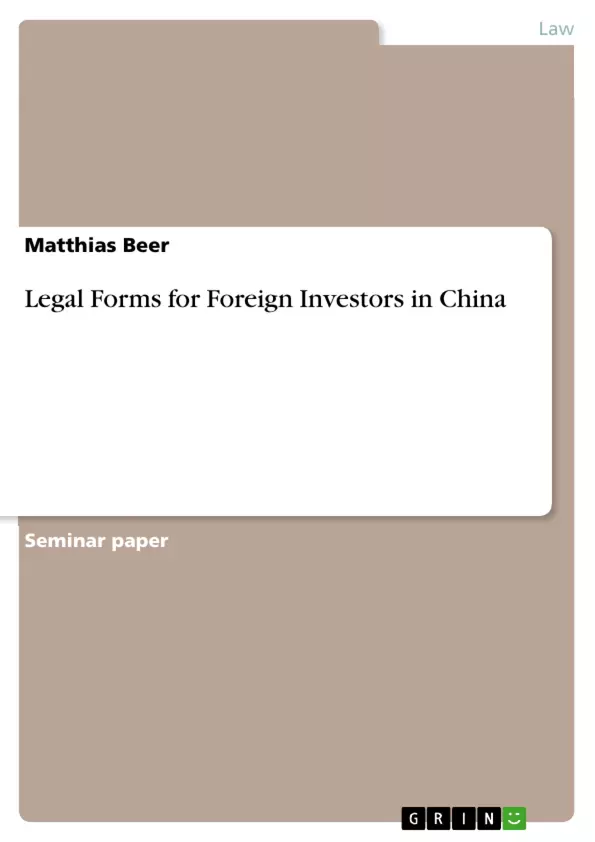Executive Summary:
Investing in China is still considered as one of the most profitable business opportunities. On the one hand side the Chinese market brings around 1.3 billion new potential consumers and on the other an annual growth rate of around 10%, both are quite attractive for foreign investments. Moreover, the Chinese government is permanently improving the investment climate for foreign enterprises and investors by improving respectively building the required infrastructure or revising business laws and lowering market entry barriers for foreigners for instance. Investing in China is not only a subject for large and international enterprises but also for small and mid sized private companies.
China’s progress in accepting market-oriented economic and business principles as well as their 2001 entry into the World Trade Organization (WTO) is attracting foreign investors the same way as a growing Chinese middle class and low labor costs. Companies of all sizes understand that by ignoring this prospering and huge market for their goods and services or by not taking ad-vantage of the latent labor arbitrage that they are risking to fall behind their competition.
The assignment is providing some statistics on foreign investments in China, is dealing with a brief overview of the different industry areas for foreign compa-nies and investors in China and explains the main investment forms which can be considered for business establishment in China. The work is concluding with some general information about legal protections for foreign investors and the ITM checklist.
Table of Contents:
Executive Summary I
List of Abbreviations III
List of Figures IV
List of Tables IV
1. Introduction 5
2. Foreign Investment Categories in China 7
3. Legal Forms for Foreign Investors in China 9
3.1. Joint Venture 9
3.1.1. Equity Joint Venture 10
3.1.2. Cooperative Joint Venture 10
3.2. Representative Office 10
3.3. Wholly Foreign Owned Enterprise 11
3.4. Holding Enterprises for Foreign Investors 11
3.5. “B” Stocks 12
4. Legal Protection of Foreign Investors in China 12
5. Conclusion 13
ITM Checklist 14
References 16
Inhaltsverzeichnis (Table of Contents)
- Executive Summary
- 1. Introduction
- 2. Foreign Investment Categories in China
- 3. Legal Forms for Foreign Investors in China
- 3.1. Joint Venture
- 3.1.1. Equity Joint Venture
- 3.1.2. Cooperative Joint Venture
- 3.2. Representative Office
- 3.3. Wholly Foreign Owned Enterprise
- 3.4. Holding Enterprises for Foreign Investors
- 3.5. "B" Stocks
- 3.1. Joint Venture
- 4. Legal Protection of Foreign Investors in China
- 5. Conclusion
- ITM Checklist
- References
Zielsetzung und Themenschwerpunkte (Objectives and Key Themes)
This assignment aims to provide an overview of the legal forms available for foreign investors in China, focusing on the opportunities and challenges of establishing a business in the Chinese market. It examines the key investment categories, industry areas, and legal frameworks relevant to foreign enterprises.
- Foreign investment categories and industry fields in China
- Legal forms for foreign investors, including joint ventures, representative offices, and wholly foreign-owned enterprises
- Legal protection for foreign investors
- The impact of China's economic development and WTO membership on foreign investment
- The role of the Chinese government in facilitating foreign investment
Zusammenfassung der Kapitel (Chapter Summaries)
- 1. Introduction: This chapter provides an overview of the growing importance of foreign investment in China, highlighting the country's economic growth, large market potential, and attractive investment climate.
- 2. Foreign Investment Categories in China: This chapter delves into the various categories of foreign investment in China, including direct investment, portfolio investment, and other forms of investment. It also examines the different industry sectors where foreign companies are active.
- 3. Legal Forms for Foreign Investors in China: This chapter provides a comprehensive overview of the legal forms available for foreign investors in China, including joint ventures, representative offices, and wholly foreign-owned enterprises. It examines the advantages and disadvantages of each form and the legal requirements for establishment.
Schlüsselwörter (Keywords)
The text focuses on key concepts related to foreign investment in China, including legal forms for business establishment, investment categories, industry sectors, legal protection, and the impact of China's economic development and WTO membership. Other important terms include joint ventures, representative offices, wholly foreign-owned enterprises, intellectual property, and the ITM checklist.
- Quote paper
- Dipl. Ing. MBA Matthias Beer (Author), 2011, Legal Forms for Foreign Investors in China, Munich, GRIN Verlag, https://www.grin.com/document/233249



